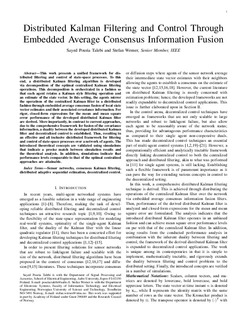Distributed Kalman filtering and control through embedded average consensus information fusion
Journal article, Peer reviewed
Accepted version

Åpne
Permanent lenke
http://hdl.handle.net/11250/2624922Utgivelsesdato
2019Metadata
Vis full innførselSamlinger
Originalversjon
IEEE Transactions on Automatic Control. 2019, 64 (10), 4396-4403. 10.1109/TAC.2019.2897887Sammendrag
This paper presents a unified framework for distributed filtering and control of state-space processes. To this end, a distributed Kalman filtering algorithm is developed via decomposition of the optimal centralized Kalman filtering operations. This decomposition is orchestrated in a fashion so that each agent retains a Kalman style filtering operation and an estimate of the state vector. In this setting, the agents mirror the operations of the centralized Kalman filter in a distributed fashion through embedded average consensus fusion of local state vector estimates and their associated covariance information. For rigor, closed-form expressions for the mean and mean square error performance of the developed distributed Kalman filter are derived. More importantly, in contrast to current approaches, due to the comprehensive framework for fusion of the covariance information, a duality between the developed distributed Kalman filter and decentralized control is established. Thus, resulting in an effective and all inclusive distributed framework for filtering and control of state-space processes over a network of agents. The introduced theoretical concepts are validated using the simulations that indicate a precise match between simulation results and the theoretical analysis. In addition, simulations indicate that performance levels comparable to that of the optimal centralized approaches are attainable.